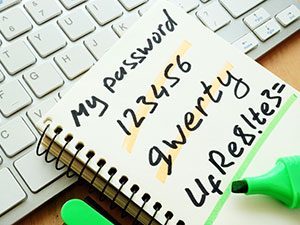 The most effective way to keep from having your life turned upside down by someone hacking into one of your online accounts is to begin actively managing the passwords to all your accounts. Of course, that’s easier said than done when considering all the accounts you maintain. Two strategies that are relatively simple to use, but add greatly to the challenge a hacker will face if trying to break into your account:
The most effective way to keep from having your life turned upside down by someone hacking into one of your online accounts is to begin actively managing the passwords to all your accounts. Of course, that’s easier said than done when considering all the accounts you maintain. Two strategies that are relatively simple to use, but add greatly to the challenge a hacker will face if trying to break into your account:
- Use multifactor authentication – where another piece of data is required in addition to your userid and password. This is required by a growing number of financial institutions and popular social networking services.
- Use an online password manager – such as Roboform or LastPass (there are many others).
Unfortunately, an alarming number of people still don’t use even the simplest password protection practices.
According to security experts, the core problem with passwords is the trade-off between security and convenience. Simply making a password more complex can actually backfire because it becomes impossible to remember.
The worst passwords
Each year, SplashData, a provider of password management products, releases the top 25 most used passwords appearing on lists of stolen passwords released on the internet throughout the year. Just glancing down the top 10 of the 2014 list can reveal why so many people have their accounts hacked:
- 123456
- password
- 12345
- 12345678
- qwerty
- 1234567890
- 1234
- baseball
- dragon
- football
Simple password do’s and don’ts
If you didn’t follow our previous suggestions regarding multi-factor authentication or password management systems, here are some dos and don’ts from SplashData and others on protecting your passwords:
- Don’t use simple patterns on your keyboard such as “qwertyuiop,” which is the top row of letters on a standard keyboard, or “1qaz2wsx” which comprises the first two ‘columns’ of numbers and letters on a keyboard.
- Don’t use a favorite sport or team name as your password.
- Don’t use your birthday or especially just your birth year.
- Don’t use children’s names as a password.
- Don’t use the same password on multiple accounts. If you do, it’s like having all your cash and credit cards in one wallet, and having the wallet stolen.
- Don’t use swear words and phrases, hobbies, famous athletes, car brands, and movie names.
- Do use passwords of eight characters or more with mixed types of characters.
- Do change passwords often — at least once a month on any account that can be used to withdraw money or make purchases.
How to create a password using a “password phrase”
Here is a suggestion for how to create a password from Norton, the internet security company.
- Create a password phrase. For this example, we’ll use the phrase: “I like to support local shops.”
- Convert your phrase to an abbreviation by using the first letters of each word and changing the word “to” to a number “2.” Using the example phrase:il2sls
- Put the first and last letter of the website you are using as the first and last letters of your password phrase, and capitalize the last letter. For example, let’s use the first and last letters of “Google” with our phrase: gil2slsE
The advantage of using a pass phrase is that it is easy to remember since it’s something personal to you, but something you can make unique for each website requiring a password. Smallbusiness.com


